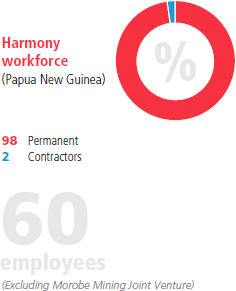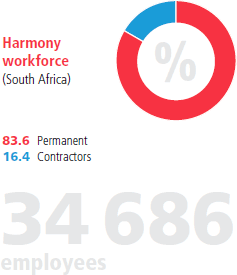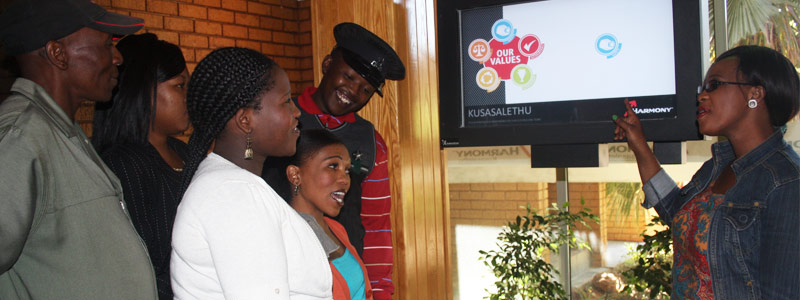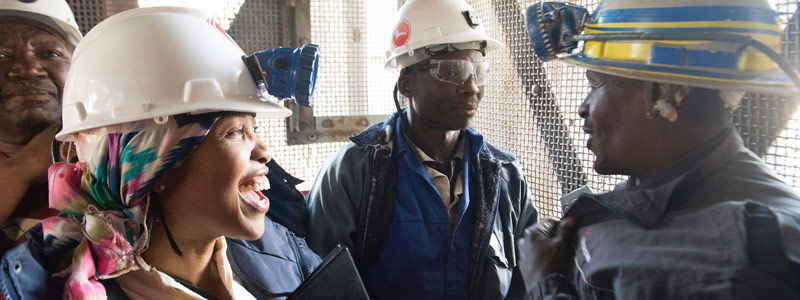EMPLOYEES
Why this is material to Harmony
Employees are the most valuable asset we have at Harmony – without them we would not be able to continue operating.
Our employees contribute to the growth and development of our company and we, in turn, contribute to the growth and development of our people. Our aim is to provide the means for our employees to achieve a good quality of life for themselves and their families, and to provide the opportunity for each individual to develop to his or her full potential.
In a similar way, we could not do what we do without the support of our host communities, and we aim to go leave a meaningful legacy in these areas.
At the end of FY14, in South Africa, our employee complement was 34 686 (FY13: 36 424) – 83.6% permanent employees and 16.4% contractors. In Papua New Guinea, the staff complement of 60 excludes Morobe Mining Joint Venture employees (FY13: 155). Of these, 98% were permanent employees and 2% were contractors working on specific construction projects. Our recruitment initiatives focus on local communities, with over 76% of the South African workforce derived locally, and in Papua New Guinea 88% is derived locally.


Relevant material issues: maintaining stability in our workforce, protecting our licence to operate and managing our impact.
| Objectives | Progress in FY14 |
|---|---|
| 909 family units by 2014 by converting hostels to community rental units |
The award winning Masimong 4 housing estate project, which accommodates 461 families, is 100% completed. Merriespruit 3 housing project was 60% completed by June 2014 and we are on track to complete this project by December 2014. Merriespruit 3 will provide another 448 family units, bringing our total family units to 909. |
| Productivity improvement initiatives | Ongoing |
| Standardisation of human resources policies and processes | Completed June 2014 |
| Completion of adult basic education and training programme by 2015, with literate workforce by 2024 | We will not complete adult basic education and training in 2015 but still aim to have a fully literate workforce by 2024. During FY14, 880 employees attended our adult education and training programme (FY13: 912). |
Given our objective to have motivated and competent employees, our human resources initiatives focus on four underlying goals, to:
- Entrench a single organisational culture
- Attract and retain employees with high potential
- Develop employees to address skills shortages and improve efficiency
- Maintain an effective employee performance management system
Communication campaign
Our recent communications campaign was built on our Connect value and designed to bring our employees on the Harmony journey by keeping them informed with company news at all times. This, we hope, will continue to grow our employees’ pride in Harmony and encourage them to become Harmony Brand Ambassadors.
The look and feel of all our communication is friendly and easily understandable, and is available in English, Xhosa and Sotho. Given the varying levels of literacy within Harmony, written communication is not enough and so we have also embarked on a campaign to make all our employees feel that their voice is being heard. Our connect officers, in partnership with our leadership teams, engage with employees and their union representatives, and make sure to respond to the feedback we receive.
As part of the campaign, we held a workshop in May 2014 that trained our Connect Officers in the art of improving staff engagement at their mines. Our two speakers, Steven Green (general manager of Bambanani/Unisel) and James Mafura (regional general manager), shared their experiences of how to connect with people and the value this held.
The response from this campaign has been positive, with mines that have embraced the Connect value showing excellent team work and improved performance.
The first phase of our culture alignment programme was completed in FY14. The programme is aimed at achieving cohesion throughout the company through three steps: leadership shaping; empowerment; and employee engagement.
Leadership shaping encourages our senior leadership to set Harmony’s cultural direction and devise tactics to help achieve this. This includes a well-defined set of values, which were an outcome of the 2011 culture survey, as well as a Harmony leadership brand that is cascaded from senior leaders to leaders below them through a coaching leadership approach. This process is assisted by a suite of BreakThrough programmes, enabling our leaders to drive our preferred company culture down the various layers of Harmony. This step of the programme leads to the next – an empowered leadership team who continually shape the Harmony culture of safety and accountability. Finally, the employee engagement phase consists of our company-wide culture surveys as well as our bottom-up employee engagement initiatives, such as business improvement sessions or workgroups.
Our culture alignment programme aims to achieve a culture of high performance, the progress against which is measured every Securities and Exchange Commissionond year as part of the broader company culture survey. In 2013, a sample of 12.5% of Harmony’s total workforce participated in the second culture survey, which indicated a 5% drop in culture entropy from 2011 (23%) to 2013 (18%). This is a significant improvement and is a strong indicator that there is less frustration and misalignment in the Harmony culture. To improve our score even further we have monitored problem areas and implemented initiatives to improve our culture. The Connect value, in particular, is one area on which we focused to ensure that our employees feel part of the Harmony family.
Early indications show that those leaders who have embraced and driven a single culture are outperforming their peers in terms of production and safety. The lower incidence and decreased impact of industrial action also points to a more aligned culture where people are more engaged and are able to contribute.
Employment standards
In South Africa, employment policies and practices are governed by the Labour Relations Act 66 of 1995, the Basic Conditions of Employment Act 75 of 1997, by company and operation-based recognition agreements and by other collective bargaining agreements.
The company provides a wide range of benefits to employees which include sick, annual and maternity/paternity leave; production and performance-based bonuses; housing and housing allowances; home ownership benefits; funeral fund; medical aid; disability cover; and provident and pension funds.
In Papua New Guinea, efforts to reduce the reliance on contractors within the Morobe Mining Joint Venture and Harmony operations continued in FY14, resulting in further reductions in the contractor workforce by the end of the year under review. A review of all human resource procedures and policies is ongoing, including remuneration and incentive schemes.
Remuneration policy
Our remuneration policy is aligned to Harmony’s strategic direction, business-specific value drivers and operational results at all levels across the company. (See the remuneration report for our full remuneration policy).
Share ownership: South Africa
In FY12, Harmony launched the Tlhakanelo Employee Share Ownership Plan which resulted in over 33 000 employees becoming eligible to be shareholders with a potential stake of 2.9% in Harmony. This gives employees the opportunity to share in Harmony and see the fruit of their hard work, in line with our values of achievement and connectedness.
All non-managerial employees have access to the scheme. The rules of the scheme are communicated through offer, vesting and allocation letters. In addition, human resources leaders receive frequent training to ensure that employees have a point of contact should they have any questions. We also use the mine-based audio-visual facilities to communicate some of the scheme information. For more information please refer to the remuneration report.
Labour disputes and strikes
Labour disputes and strikes are considered one of our material issues because, in addition to loss of production, disputes affect morale and reputation, and present a risk to non-striking employees, to communities and to company assets. (Full details under material issues).
To mitigate the risk of labour disputes in South Africa we constantly engage with organised labour at mine and company level. We adopt a proactive human resources approach to address employees’ queries.
Harmony has embarked on various initiatives to address the scourge of employee over-indebtedness. These include, among other things, financial literacy training, discontinuation of non-statutory payroll deductions, and notification of employees about emolument attachment orders against their pay. A total of 5 593 employees have attended the financial literacy programme since its launch in September 2013. A multi-stakeholder workshop was held in March 2014 to consider various ways to address the issue of emolument attachment and garnishee orders against employees’ wages. The Harmony Employee Relations Framework Agreement will be finalised in the course of FY15.
MAINTAINING PEACE AND STABILITY IN OUR WORKFORCE
Maintaining peace and stability in our workforce is something we always endeavour to do and the prolonged strike in the platinum sector has prompted us to do even more. We want our employees to feel safe at work and safe to work, a satisfaction that is a direct result of stability. For more on this issue see our Material issues.
Our multi-union environment promotes co-existence, inclusion and collaboration. Our value of accountability extends to our unions, with all labour relations structures and processes being bound by national legislation, agreement and best practice. In addition to quarterly regional meetings with our unions, we also encourage proactive and robust engagement to address issues, which we follow up with prompt action. Because communication needs to be ongoing at all levels we also have daily contact with full-time stewards, while our general managers/human resources leaders have regular interactions with both the branch levels and shaft committees. The Harmony council also engages with the unions on a wide range of employee-related issues, such as housing and employment equity.
Since we value the instrumental role our employees play in our business, we think it is important to share the news of the business with the unions. We do this through monthly communication of operational performance to the union structures.
We also work directly with our employees to address a number of issues that are key to our relationship with them. These include reviewing productive incentives, introducing financial literacy to address the problem of indebtedness and replacing payroll deductions with a new system to manage emolument attachment orders and garnishee orders.
We will continue this work in FY15 and hope to keep improving both our relations with employees and their daily experiences at Harmony.
Below are some of the key themes being gathered from the feedback of those who have been on the programme:
- The devastating effect that debt has had on their family’s lives
- A desire to be in control of their own spending, and imagining a life without debt
- Recognition that they do not have power over their spending
- Strong awareness of the need to budget
Other initiatives still being rolled out include the verification of emolument attachment orders by the National Debt Mediation Association and the launch of a helpline for financially troubled employees.
In Papua New Guinea, we participate in ongoing engagement with all stakeholders, including employees, provincial and local government, landowners and regulators.
During FY14, despite some sporadic site specific strike action within the company, the general climate was stable. Harmony was also not affected by the strike action which affected the platinum sector in South Africa’s Rustenburg area.
In Papua New Guinea, in September 2013, two days were lost due to illegal strike action at Hidden Valley when a wage increase was below employees’ expectations. Further illegal strike activity occurred in March 2014, when six days were lost due to grievances, which were tabled and addressed by the Employee Representative Council and employees.
Freedom of association
We recognise the right of employees and contractors to freedom of association and adhere to collective bargaining agreements in each country. Honesty is one of our values and we strive for honest, two-way discussions through collective bargaining.
In South Africa, Harmony recognises four labour unions, namely the Association of Mineworkers and Construction Union (Association of Mineworkers and Construction Union); the National Union of Mineworkers; Solidarity and UASA. About 93% of our South African workforce is unionised, with a further 3% covered by agency shop agreements. The balance of 4% is non-unionised.
In FY14, a recognition agreement with Association of Mineworkers and Construction Union was signed at Kusasalethu. We are pursuing a number of initiatives to reinstate a multiunion environment at Kusasalethu.
There are no active unions at our Papua New Guinea sites. Industrial relations at Hidden Valley are currently managed by the employee representative committee.
Restructuring of South Africa’s Doornkop operations
In November 2013, Association of Mineworkers and Construction Union, National Union of Mineworkers, Solidarity and UASA were given notice in terms of section 189A of the Labour Relations Act of the intention to restructure Doornkop operations, as a result of the closure of the Kimberley section which had reached the end of its mining life. This closure plan potentially affected a total of 519 employees. Voluntary and compulsory retrenchments were limited to 267 employees, with the remainder of jobs affected being dealt with through transfers and reskilling.
Target 3 operation placed on care and maintenance post year-end
In August 2014, the Company announced that Target 3 commenced with a section 189A of the Labour Relations Act and will subsequently be placed on care and maintenance by November 2014.
South African gold wage negotiations
Harmony negotiates changes to wages and other conditions of employment through recognised collective bargaining structures, including a centralised industry forum under the Chamber of Mines. Negotiations began in July 2013 and the gold sector wage agreement was signed on 10 September 2013 with the National Union of Mineworkers, UASA and Solidarity, after National Union of Mineworkers’s four days of strike action. Recent rulings by the Labour Court have upheld the validity of the extension of the agreement to all employees, despite efforts by Association of Mineworkers and Construction Union to pursue protected strike action.
Socio-economic, political and regulatory changes
Our company, employees and communities are affected by socio-economic, political and regulatory changes and our efforts to keep abreast of these. Changes include amendments to labour legislation and political and regulatory changes. Our compliance efforts directly impact on our social license to operate and thus our sustainability. We endeavour not just to comply with laws and regulations but to go the extra mile. We conduct regular meetings with community leaders to address community concerns and perceptions.
Training and development in South Africa
We are in competition for key human resources and critical skills. Upskilling in core and critical areas increases the skills pool and lends stability to continued operations.
Employee development is pivotal to Harmony’s strategic and operational delivery. All training and development programmes are carried out in line with the company’s strategic and operational needs through a wide range of programmes. These include skills development, Adult Education and Training, the bridging school, learnerships, bursaries, graduate development, talent management and supervisory and leadership development. Some 4% of payroll is spent on human resources development.
In addition to upskilling our own employees we recognise that community members could benefit from our programmes. We also spend considerable effort on programmes such as bursaries and the bridging school – that allow young learners from local communities to improve and continue their studies. This has the potential to benefit Harmony in the long run too, as it encourages promising students to take on careers in fields in the mining industry.
In FY14, 62% of our workforce received some form of training, at a cost of R283 million (US$27 million) (FY13: 74%, R242 million/ US$27 million). In FY14, a total of 56 people were trained in critical skills at a cost of R1.1 million (US$0.1 million), compared with 124 people in FY13 at a cost of R5.1 million (US$0.6 million). To facilitate transformation in South Africa, 67% of employees trained in FY14 were historically disadvantaged South Africans and 12% were women.
Adult education and training
Adult education and training centres at Harmony’s South African operations run full-time classes to address the level of basic education in our workforce. In FY14, 1 099 employees and community members were enrolled for classes, at a cost of R52 million (US$5 million).
The overall results in 2014 remained disappointing, with a 41% overall pass rate. However we have noticed improvement in the pass rate on first attempt to 63% of people who wrote exams. The introduction of the adult education and training incentive for people who pass on first attempt and adult education and training award ceremonies will assist in improving the overall pass rate over a period.
Our Papua New Guinea operations are in their early stages and currently only offer part-time adult education and training courses. However, work commenced on an adult literacy and numeracy programme in Wafi-Golpu and Hidden Valley communities. In FY14, Morobe Mining Joint Venture trained 15 teachers for this programme in the region around Wafi-Golpu and a class of 42 people enrolled in the Hekeng Village, with classes starting on a part-time basis. The total expenditure on the programme was R0.6 million (US$0.058 million).
Bursary programme
Harmony offers a bursary programme and a subsequent graduate development programme. Harmony awarded a total of 38 bursaries for university studies during 2014, with 24 (63%) of these students coming from our local communities.
| Discipline | Total | 4th Year | 3rd Year | 2nd Year | 1st Year | Total Gender | |||||
|---|---|---|---|---|---|---|---|---|---|---|---|
| Gender | M | F | M | F | M | F | M | F | M | F | |
| Mining | 16 | 5 | 0 | 2 | 1 | 3 | 2 | 1 | 2 | 11 | 5 |
| Engineering | 7 | 2 | 0 | 1 | 0 | 2 | 0 | 2 | 0 | 7 | 0 |
| Survey | 2 | 0 | 0 | 0 | 1 | 0 | 0 | 1 | 0 | 1 | 1 |
| Other – Services | 13 | 0 | 0 | 0 | 1 | 0 | 0 | 7 | 5 | 7 | 6 |
| Total | 38 | 7 | 0 | 3 | 3 | 5 | 2 | 11 | 7 | 26 | 12 |
Each year Harmony endeavours to hire its graduating bursars to meet needs in our company. Below is a table indicating how many individuals were hired from this programme each year:
| 2014 | 2013 | 2012 | 2011 | 2010 | |
|---|---|---|---|---|---|
| Number of bursars hired at Harmony | 6 | 13 | 5 | 4 | 4 |
Bridging school
Harmony’s bridging school supports mathematics and science at grade 12 level to assist school leavers in improving their final results to gain admission to tertiary studies. Upon successful completion of their grade 12, some get awarded bursaries while others follow the learnership route, increasing the number of learnerships intake for the company.
In January 2014, we selected 20 learners for our bridging school programme, including 12 who are interested in furthering their careers in mining and eight in engineering. These learners are predominantly from our mining communities. Of the total learners, nine (45%) have parents and/or close family members working at Harmony.
To date, we have registered a total of 355 students from local communities at the bridging school, of which 34 (10%) were awarded bursaries and most of them have been appointed into management positions, 160 (45%) went through learnerships and the rest have been employed in various positions.
Learnerships
Three formal learnership programmes are in place at Harmony: rock breaker, artisan and service persons. In FY14, Harmony had 283 active learners at different levels in their respective learnership programmes, of whom 81 completed their learnerships and most of them have been appointed to pertinent positions.
Internship and experiential programmes
In support of our Social and Labour Plans, Harmony hosted 31 students (20 internships and 11 experiential trainees) during FY14. Ten of these students have completed their exposure programmes during the year and we currently have a total of 21 students, made up of 17 interns and four experiental trainees.
Training and development in Papua New Guinea
In Papua New Guinea, a three-year training plan to 2015 is in place for our three joint ventures. To address operational requirements and retain employees at our Papua New Guinea operations, mentoring and skills development programmes are undertaken. We continue to train and mentor locally-recruited employees from the landowner areas of Hidden Valley. Specific initiatives in FY14 included:
- Personal development courses for 518 people
- Development of level 2 of supervisor development programme for mining supervisors
- Integration of level 1 programme for drill and blast supervisors and coordinators
- Information and technology training for trainer supervisors
- Tier 1 and 2 induction and training for 2 115 and 1 177 participants respectively
- Operator efficiency training
Hidden Valley has recently developed its lines of progression training and skills matrix. This gives employees a clear understanding of the skills required to perform their current function and those levels above them, a first step in providing a career path programme. Implementation began in May 2014.
Employment equity
Giving each and every one of our employees a fair chance in the workplace is a moral imperative for Harmony. As a result, employment equity is something that we give weight to; taking into consideration the historical context of the areas we work in to ensure equality wherever possible.
Our policy is to recruit locally as far as possible. However, our policies and procedures ensure there is no discrimination against foreign migrant labour, which constituted about 35% of the workforce in FY14 (FY13: 35%).
We understand the legacy of the migrant worker system and have various initiatives in place to address the different elements of this. We ensure that our employees are able to return home regularly. We also aim to make it easier for employees to have their families visit them by having spouse quarters for visiting family members. Our hostel de-densification programme ensures that employees have access to private living space. To make it possible for employees to move their families closer to our operations, our hostel conversion programme is making family units available; we also seek to make provision for family accommodation in local towns. Harmony is aware that our corporate social responsibility extends beyond the surrounding communities and so we also have a number of local economic development projects in labour-sending areas, such as Mozambique and Lesotho, as well as an agreement to provide home-based care to medically incapacitated employees from all areas.
A representative workforce is both a legislative and moral imperative in South Africa, one which ensures economic growth benefits all stakeholders. The company reports its employment equity plan and progress to the social and ethics committee quarterly and to the departments of labour and mineral resources annually.
In FY14, 46% of all Harmony’s management staff were historically disadvantaged South Africans, meeting the Mining Charter targets for company level compliance. Women employed at management level stood at 20% (FY13: 20%). There is no difference between salary scales for men and women at Harmony.
| Targets (historically disadvantaged South Africans) | |||||
|---|---|---|---|---|---|
| Occupational categories | 2013 | 2014 | 2015 | 2016 | 2017 |
| Top management (board) | 35 | 40 | 45 | 50 | 55 |
| Executive management | 35 | 40 | 45 | 50 | 50 |
| Senior management | 35 | 40 | 45 | 50 | 55 |
| Middle management | 40 | 40 | 50 | 55 | 60 |
| Junior management | 40 | 40 | 50 | 55 | 60 |
| Core and critical | 30 | 40 | 45 | 50 | 55 |
In Papua New Guinea, we are focused on attracting and retaining both externally and locally recruited employees, particularly landowners and local citizens. Operations are governed by a three-year training plan lodged with the Department of Labour. Under this plan, the joint ventures must ensure locally sourced employees are continuously trained and succession is managed. The succession target of under 8% permanent externally-sourced employees has been reached, with our actual rate at 7% across the three joint ventures. Morobe Mining Joint Venture is currently operating Hidden Valley with 7.8% non-citizens; Morobe Exploration with 7.5%; and Golpu with 6%.
At Hidden Valley, women in the workforce stood at 13% in FY14, below the national average of 15%. All efforts are focused on achieving a target of 15% by the end of FY15.
HOUSING AND LIVING CONDITIONS: SOUTH AFRICA
In South Africa, housing and living conditions has long been a critical issue in the mining industry as we work to address the systems of the past.
Our housing strategy is focused on promoting home ownership, rental options and integrating mining communities into local structures. We make land available and facilitate affordable housing development on our redundant mine land – for all new developments we fund construction of infrastructure such as power and water, manage the project and monitor quality. We also proclaim mine villages to become part of municipal areas. In line with our focus on promoting home ownership, employees who do not live in company hostels received a living-out or housing allowance.
| Mining Charter target 2014 | Harmony target 2015 | 2013 | 2014 | Planned 2015* | ||||
|---|---|---|---|---|---|---|---|---|
| % | Achieved | % | Progress | % | Planned | % | ||
| Hostel (operational) conversion to single rooms by 2014 | 100 | 8 658 | 1 102** | 13 | 1 678** | 19 | 8 658 | 100 |
| Hostel (non-operational) conversion to family units | 100 | 1 100 | 561 | 61.7 | 761 | 69 | 1 100 | 100 |
| Facilitation of home ownership*** | 4 719 | 2 496 | 53 | 2 800 | 59 | 4 719 | 100 | |
| Total | 42% | 49% | 100 | |||||
- *Certain elements are outside Harmony’s control, such as employees being granted bonds or receiving state subsidies
- ** The number reported for 2013 and 2014 only represents units in 100% converted hostels. The number of single rooms, including those in uncompleted hostels, totals 5 027 in FY14 (FY13: 3 214)
- *** Houses sold to employees and other housing development programmes (actual achieved will depend on employee affordability profile and ability to obtain finance)
Our housing programme is specifically aimed at converting and upgrading hostels to attain the occupancy rate of one person per room and converting and upgrading hostels into family units. Improving the living conditions of our employees is directly linked to employee well-being and productivity. Our housing programme also creates jobs and supports local business.
In FY14, the number of hostel dwellers sharing declined from 8 629 (FY13) to 6 841, with single occupants moving to 19% from 13% in FY13, in 100% completed hostels. Although we only show a 19% compliance, it is based on a very conservative definition for the indicators. However, as a group, we have already completed 5 027 rooms against a target of 8 658 rooms. Harmony is scheduled to meet its target of one person per room by December 2014. Rooms in all hostels (including incomplete hostels) amount to 58% progress in FY14 (FY13: 44%). We aim to build 1 100 family units over four years. Some 761 units have been built to date, 69% of the total planned. Merriespruit 3 is in progress while Deelkraal is in feasibility stages.
In order to further facilitate home ownership, Harmony subscribes to and supports the pension-backed home loan scheme as negotiated at Chamber of Mines level, and over 1 100 of our employees have already made use of this facility. During the previous financial year a further 480 of our houses were purchased by our employees by way of a ‘rent-to-own scheme’.
HUMAN RIGHTS
Respect for human rights is entrenched within the company’s values and specifically catered for in human resources policies, charters and contracts of engagement. This is closely monitored by human resources and community engagement managers at operational level.
We abide by the human rights conventions of the International Labour Organization, as supported by the South African constitution. Our adherence is monitored by the social and ethics committee. In addition, certain human rights requirements are built into contracts with new suppliers.
No incidents of discrimination were reported in South Africa or Papua New Guinea in FY14.
The South African constitution also prohibits forced, compulsory or child labour. None of Harmony’s operations are at risk and no contraventions of these principles were alleged or reported in FY14.




